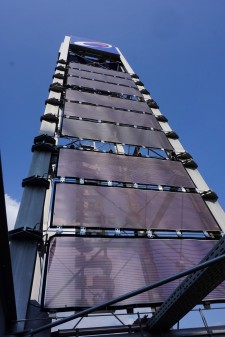The World's First Grid-Connected OPV System Has Been Running Reliably Since 2012

Nuremberg, Germany, October 7, 2016 (Newswire.com) - In 2012, the world's first grid-connected OPV (organic photovoltaic) system was commissioned at Mainova AG in Frankfurt. This system is not only the first ever grid-connected OPV system, but also the one longest in operation. Since 2012, nine flexible and transparent OPV modules in the form of a sun sail, with a total capacity of 0.2 kW, have graced a building on the energy provider's premises. The defined objective of the installation at that time was to provide answers with regard to various aspects: to tap into the potential benefits of OPV in the area of static and mechanical integration, to examine the characteristics of OPV in power supply operation and, finally, to verify stability during continuous operation.
During the planning and installation phase, answers relating to some of the areas in question were already found. It became evident that, due to the low weight of the OPV modules in conjunction with mounting in a higher position, a significant reduction in costs for the static strengthening of the logo tower could be achieved. In addition, the installation of the modules proved to be simple and straightforward, which, last but not least, was confirmed by the BELECTRIC OPV follow-up projects.
Four years trouble-free operation, with no apparent degradation, a higher energy yield than expected and Mainova a satisfied partner.
Hermann Issa, Director of Business Development and Marketing at BELECTRIC OPV
After four years of operation, the electrical data of the system was also subjected to detailed inspection. This system, with a nominal output amounting to 0.2 kW (before system losses), is mounted vertically and aligned to the south. In order to evaluate the recorded yield data, a commercial PV simulation software (PVSYST) was used to image the system and the characteristics of the OPV modules (good low light response, large angular range, positive temperature coefficient, etc.). With the help of historical weather data, the expected yields over the current system running time were simulated and compared with the actual measured yield data (AC side).
This shows that, since commissioning, the system has achieved an additional yield of 7% compared to the simulation, whereby, in the simulation, an annual degradation of 0% / year was adopted. Accordingly, after four years of operation, the OPV system has achieved an even higher yield than was to be expected given the installed nominal output.
After this period, it is also important to observe a further parameter that receives less attention in classical photovoltaics: what is known as EPBT (energy payback time), the period of operation which is necessary to produce the amount of energy that was previously consumed for the production of the modules and the materials used. With traditional photovoltaic modules, it can be assumed that an overall energy balance has been reached after two to four years, generally speaking. In contrast, the OPV system at Mainova has been producing a surplus for more than three years, due to the short EPBT of only 10 months (for the current location).
"Four years trouble-free operation, with no apparent degradation, a higher energy yield than expected and Mainova a satisfied partner, are confirmation of our good work. Finally, the system was built to the 2012 level of technology. Since then we have made great progress in terms of performance and integration. With our current possibilities, such a project would look different, even better, and achieve higher yields. With the knowledge that OPV technology development is continuing to advance, we are in a good position to meet the future," adds Hermann Issa, Director of Business Development and Marketing at BELECTRIC OPV.
The increase in output of the current generation of OPV materials does not however negatively affect other parameters. In this connection, Merck KGaA and the BELECTRIC OPV GmbH, strategic partners in the field of material development, will jointly present results from high performance OPV materials at the 9th ISOS Conference in October 2016 in Freiburg. The results show that also these OPV materials, with their significantly increased energy yield, are at least as stable as their predecessors.
“For us this is a very important result,“ said Richard Harding, Global Head of Business Development – Photovoltaics, at Merck Performance Materials. “For very young and disruptive technologies like OPV it is naturally difficult to demonstrate long term performance with real-time data, and we have so far had to rely on accelerated life-time tests. We are very happy to see the good lab results being realized so well in real-life applications, further underlining the potential of OPV as next generation PV technology.”
Source: BELECTRIC OPV GmbH
